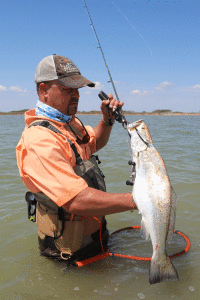
Big trout like this one are rare, but can be found just about anywhere along the Texas coast. The key to catching a wall hanger is to be in the right place, at the right time with the right lure. Robert Sloan photo
Guide Charlie Paradoski had positioned his boat along the edge of a shell reef so we could quietly make a drift with the wind while working Assassins under Bomber Paradise Popper rattle floats on West Matagorda Bay. The water depth was about 6 feet and the occasional mullet could be seen on the surface.
“This should work,” he said. “We’ve got the key ingredients – mud, mullet and shell. We’ve caught some good trout in here over the past couple of weeks.”
We were with Mike Vincent, who had never fished on the coast. He’s a bass fisherman that’s normally at home on Falcon Lake in South Texas. On his first cast he just about had the rod yanked out of his hands. He set the hook and a trout weighing somewhere between 7 and 10 pounds wallowed on the surface and was off the hook that fast. Paradoski and I were bug-eyed.
“Was that a good one?” asked Vincent.
“That’s one of the biggest trout I’ve seen in a good while,” said Paradoski. “Unbelievable!”
That’s pretty much the story while fishing for big trout. You never know what the next bite is going to deliver.
The heaviest trout in the Texas record books was caught by Bud Rowland on the Lower Laguna Madre. While fly fishing on May 23, 2002, Rowland caught and released a speckled trout that measured 37 ¼ inches and weighed 15 pounds, 6 ounces. It not only gave us a new state record but is also a new IGFA line class world record. Rowland caught that trout on a fast sinking crab imitation fly. He actually saw the huge trout in about 2 feet of water, made the cast and she ate the fly.
Trophy trout angler Jim Wallace caught the second heaviest trout on record. She weighed 13 pounds, 11 ounces and was caught on Feb. 6, 1996. On that day Wallace was fishing with Ed Stedman and Ronnie Sellers. They were on some huge trout that included Wallace’s state record, Stedman’s 12-1/4-pounder and Seller’s 11-pounder. Those are all career fish that oddly enough were hooked within minutes of each other as these fishermen waded Baffin Bay south of Corpus Christi on the lower Texas coast. They were fishing with the hottest big trout baits on the Texas Gulf Coast – “Corky’s.” That’s a slow sinking mullet imitation lure that has caught big numbers of trophy-class trout. Wallace says he used a Corky with a chartreuse/sparkle body to catch his 13-11 trout.
Trophy trout time in Texas is January through April. According to Texas Parks and Wildlife Department data trout are at their heaviest in April during the spawn. That’s when they can put on 1 to 2 pounds. And that’s when the bulk of Lone Star sows are caught. March and especially April are the prime months for searching out trophies. That’s not to say heavy specks can’t be caught during May; they can.
There’s no question about when a trout becomes wall class. A 7-pounder is close, but not quite. An honest 8-pounder is a trophy. Nine’s and 10’s will take your breath away. And state record class trout are outright Boone & Crockett’s of the speck world.
Regardless of where you’re fishing for large speckled trout it’s simply a matter of tying on a proven lure and grinding it out. The heaviest trout are almost always caught by anglers that can put in hours at a time on the water and catch very few fish. It’s called grinding and it’s all about caching a trophy.
Wading is the preferred way to stalk big trout that can often be extremely spooky. But it’s possible to catch big specks while easing along with the trolling motor. My heaviest trout, a 10-1/4 pounder, was caught from a boat.
What are the best lures for trophy-class trout? Put it this way, during late winter and spring trout will be feeding almost exclusively on mullet. That’s because shrimp and shad are scarce. So, it stands to reason that you’ll do best by fishing mullet imitation lures. Probably the best you’ll ever tie on is a Corky. One of the latest newcomers, that you might want to check out, is a slow-sinking Bomber Mullet.
The most exciting lure to use for trophy trout is a topwater. There is nothing quite like having a trout blow up on a topwater plug. That’s the good thing about trout – they aren’t shy about crashing a topwater lure. One of the best is a Super Spook Jr. in bone, red/white or chrome/blue. Another proven topwater plug is a Top Dog. That’s what I caught my 10-1/4 on.
When targeting trophy trout the main thing is to have confidence in where you’re fishing and the lure you are chunking.
Check this out: The length of a trout is a good way to determine its weight. According to TPWD numbers, a 24 inch speck will weigh about 5 pounds, a 28-incher 7-1/2 pounds and a 30-incher is roughly 9 to 9-1/2 pounds. So, if you catch a trout measuring 29 or more inches long you’ve got a trophy.
Never a dull moment with game wardens: Two Calhoun County game wardens spotted a skiff oystering in closed waters. As the wardens moved in, one of the occupants threw the oyster dredge overboard, along with himself. When the warden was able to get the man back in the boat, both subjects were arrested.
For the latest on fishing out of Port O’Connor check out videos, stories and lots of photos at www.luckystrikeguide.com. You can set up a guided trip with Capt. Robert Sloan by calling 409 782 6796, or email sloan288@aol.com.
